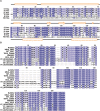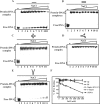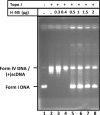Mycobacterium tuberculosis nucleoid-associated DNA-binding protein H-NS binds with high-affinity to the Holliday junction and inhibits strand exchange promoted by RecA protein
- PMID: 20176569
- PMCID: PMC2887947
- DOI: 10.1093/nar/gkq064
Mycobacterium tuberculosis nucleoid-associated DNA-binding protein H-NS binds with high-affinity to the Holliday junction and inhibits strand exchange promoted by RecA protein
Abstract
A number of studies have shown that the structure and composition of bacterial nucleoid influences many a processes related to DNA metabolism. The nucleoid-associated proteins modulate not only the DNA conformation but also regulate the DNA metabolic processes such as replication, recombination, repair and transcription. Understanding of how these processes occur in the context of Mycobacterium tuberculosis nucleoid is of considerable medical importance because the nucleoid structure may be constantly remodeled in response to environmental signals and/or growth conditions. Many studies have concluded that Escherichia coli H-NS binds to DNA in a sequence-independent manner, with a preference for A-/T-rich tracts in curved DNA; however, recent studies have identified the existence of medium- and low-affinity binding sites in the vicinity of the curved DNA. Here, we show that the M. tuberculosis H-NS protein binds in a more structure-specific manner to DNA replication and repair intermediates, but displays lower affinity for double-stranded DNA with relatively higher GC content. Notably, M. tuberculosis H-NS was able to bind Holliday junction (HJ), the central recombination intermediate, with substantially higher affinity and inhibited the three-strand exchange promoted by its cognate RecA. Likewise, E. coli H-NS was able to bind the HJ and suppress DNA strand exchange promoted by E. coli RecA, although much less efficiently compared to M. tuberculosis H-NS. Our results provide new insights into a previously unrecognized function of H-NS protein, with implications for blocking the genome integration of horizontally transferred genes by homologous and/or homeologous recombination.
Figures








Similar articles
-
Synergy between the N-terminal and C-terminal domains of Mycobacterium tuberculosis HupB is essential for high-affinity binding, DNA supercoiling and inhibition of RecA-promoted strand exchange.FEBS J. 2011 Sep;278(18):3447-62. doi: 10.1111/j.1742-4658.2011.08267.x. Epub 2011 Aug 24. FEBS J. 2011. PMID: 21787377
-
Mycobacterium tuberculosis UvrD1 and UvrA proteins suppress DNA strand exchange promoted by cognate and noncognate RecA proteins.Biochemistry. 2010 Jun 15;49(23):4872-83. doi: 10.1021/bi902021d. Biochemistry. 2010. PMID: 20455546
-
Characterization of DNA strand transfer promoted by Mycobacterium smegmatis RecA reveals functional diversity with Mycobacterium tuberculosis RecA.Biochemistry. 2003 Jun 17;42(23):7216-25. doi: 10.1021/bi0340548. Biochemistry. 2003. PMID: 12795618
-
Structure and function of bacterial H-NS protein.Biochem Soc Trans. 2016 Dec 15;44(6):1561-1569. doi: 10.1042/BST20160190. Biochem Soc Trans. 2016. PMID: 27913665 Review.
-
RecA and DNA recombination: a review of molecular mechanisms.Biochem Soc Trans. 2019 Oct 31;47(5):1511-1531. doi: 10.1042/BST20190558. Biochem Soc Trans. 2019. PMID: 31654073 Review.
Cited by
-
Functional roles of N-terminal and C-terminal domains in the overall activity of a novel single-stranded DNA binding protein of Deinococcus radiodurans.FEBS Open Bio. 2015 Apr 21;5:378-87. doi: 10.1016/j.fob.2015.04.009. eCollection 2015. FEBS Open Bio. 2015. PMID: 25973364 Free PMC article.
-
Integration host factor of Mycobacterium tuberculosis, mIHF, compacts DNA by a bending mechanism.PLoS One. 2013 Jul 26;8(7):e69985. doi: 10.1371/journal.pone.0069985. Print 2013. PLoS One. 2013. PMID: 23922883 Free PMC article.
-
The Mitochondrial DNA-Associated Protein SWIB5 Influences mtDNA Architecture and Homologous Recombination.Plant Cell. 2017 May;29(5):1137-1156. doi: 10.1105/tpc.16.00899. Epub 2017 Apr 18. Plant Cell. 2017. PMID: 28420746 Free PMC article.
-
Rv3852 (H-NS) of Mycobacterium tuberculosis Is Not Involved in Nucleoid Compaction and Virulence Regulation.J Bacteriol. 2017 Jul 25;199(16):e00129-17. doi: 10.1128/JB.00129-17. Print 2017 Aug 15. J Bacteriol. 2017. PMID: 28559300 Free PMC article.
-
Gene expression homeostasis and chromosome architecture.Bioarchitecture. 2014;4(6):221-5. doi: 10.1080/19490992.2015.1040213. Epub 2015 May 21. Bioarchitecture. 2014. PMID: 25997086 Free PMC article.
References
-
- Travers A, Muskhelishvili G. Bacterial chromatin. Curr. Opin. Genet. Dev. 2005;15:507–514. - PubMed
-
- Dame RT. The role of nucleoid-associated proteins in the organization and compaction of bacterial chromatin. Mol. Microbiol. 2005;56:858–870. - PubMed
-
- Luijsterburg MS, White MF, van Driel R, Dame RT. The major architects of chromatin: architectural proteins in bacteria, archaea and eukaryotes. Crit. Rev. Biochem. Mol. Biol. 2008;43:393–418. - PubMed
Publication types
MeSH terms
Substances
LinkOut - more resources
Full Text Sources
Miscellaneous

